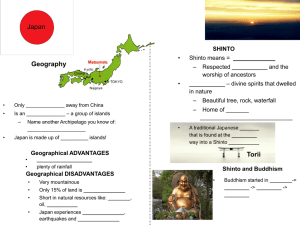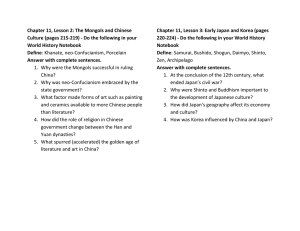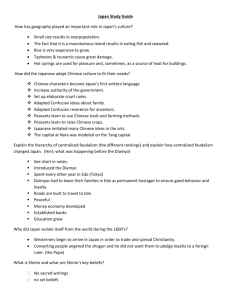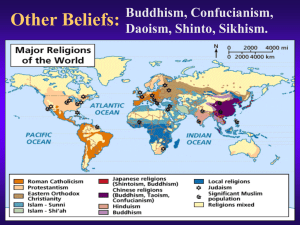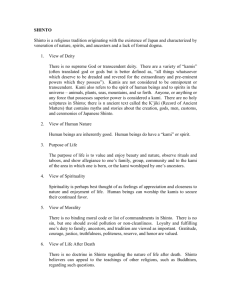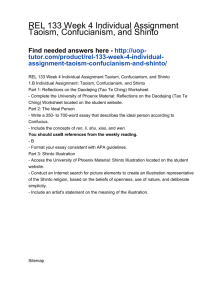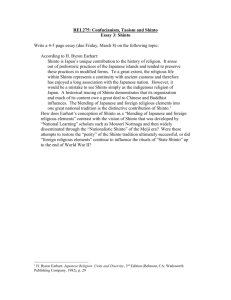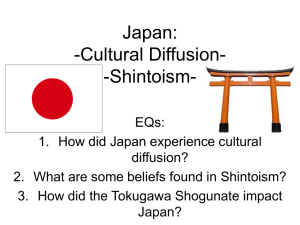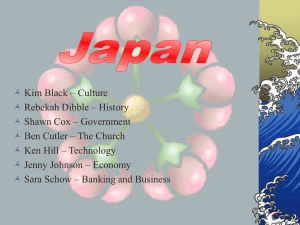8: Chinese and Japanese Religions
advertisement
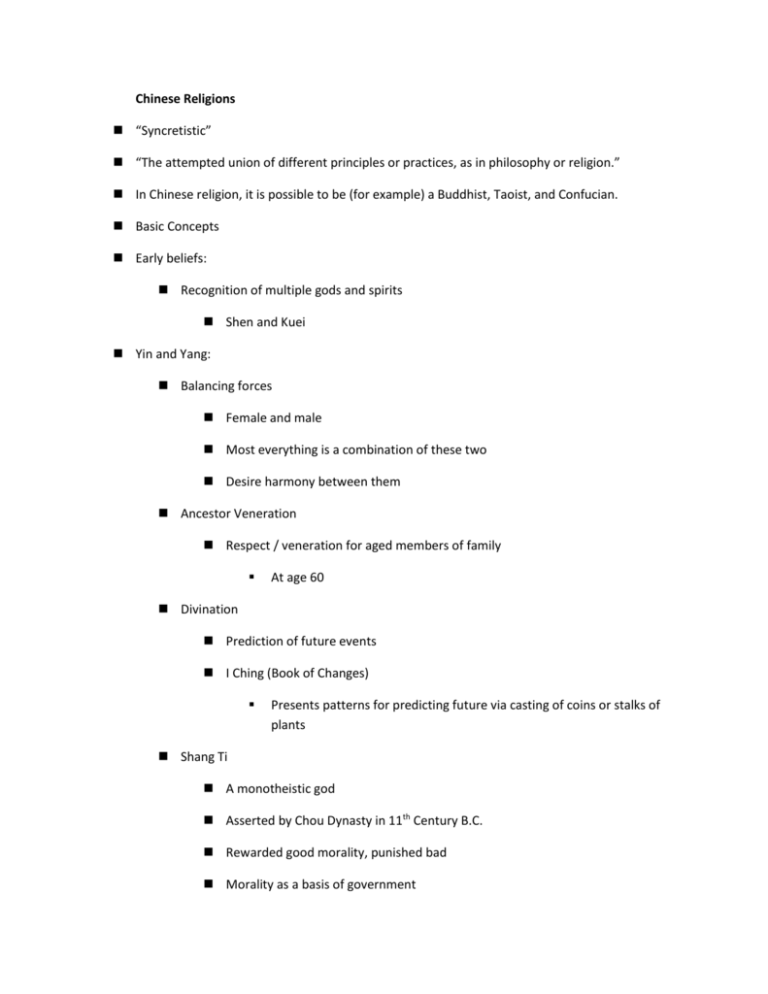
Chinese Religions “Syncretistic” “The attempted union of different principles or practices, as in philosophy or religion.” In Chinese religion, it is possible to be (for example) a Buddhist, Taoist, and Confucian. Basic Concepts Early beliefs: Recognition of multiple gods and spirits Shen and Kuei Yin and Yang: Balancing forces Female and male Most everything is a combination of these two Desire harmony between them Ancestor Veneration Respect / veneration for aged members of family At age 60 Divination Prediction of future events I Ching (Book of Changes) Presents patterns for predicting future via casting of coins or stalks of plants Shang Ti A monotheistic god Asserted by Chou Dynasty in 11th Century B.C. Rewarded good morality, punished bad Morality as a basis of government Chinese Philosophy-Religions Between 8th and 3rd Centuries BC: Feudal system had broken down Warlords; civil wars Confucians, Taoists, and Legalists each came forward with solutions Legalists (or “Realists”) Believed in strong leadership Human nature = wicked and lazy Leaders should take the hard steps needed, and not be affected by morality or pity. Had no room for religion in their system. Taoists Origins and founder are lost to history. Traditionally: Founded by Lao-tzu (“Old Master” or “Old Boy”) Based on the book, Tao Te Ching (the Way of Nature) Theme: All human achievements are folly, especially elaborate government Today: a philosophy of nature, a religion, and a system of magical practices. The Tao is the basic unity behind the universe: “The way.” Life is the greatest possession, and the only one that lasts. Ideally, individuals should turn their backs on the achievements of civilization— And live as simply and quietly as possible. The least government is the best government. Strive for the innocence of the child. Despise pomp and glory. Later Taoist developments: Own set of gods Focus on extension of life Appreciated by Chinese upper classes today as a philosophy But scorned as a religion for the ignorant masses. Confucianism Originally concerned only with society Not a religion No priests, no afterlife, no divine writings. Kung Fu Tzu: “Confucius” Born in 6th Century BC Teacher; traveled from place to place with followers. Taught about good government. Intended to develop not a religion, but: a system of ethics, a theory of government, and a set of personal and social goals. When society lives by “li,” it moves smoothly. Li = propriety; the way things should go. Works best in an idealized feudal state: All know their superiors and inferiors, Five relationships in life And can behave properly. With li present in them, society is ideal: Father to son Elder brother to younger brother Husband to wife Elder to junior Ruler to subject During the 500 years after Confucius’s death, His followers spread his ideas among the rulers of China Became integral to Chinese culture. Feng Shui Wa Chinese New Year Celebrated late Jan/early Feb. Cleansing and renewal Autumn Harvest Festival (lantern festival?) Japanese Religions Shinto Loosely organized, native Japanese religion Wide variety of beliefs and practices A religious form of Japanese nationalism Japan superior to other lands Includes aspects of animism and ancestor worship. Kami: Gods or humans with godlike powers. Also—anyone or anything possessed of superior power (awesome). Japan: was created by two kami. All Japanese emperors are descended from them. 4th Century: Chinese religions impacted Japan. Mahayana Buddhism especially. Shinto and Buddhism blurred together; Shinto became concerned with daily life; Buddhism with the afterlife. Zen Buddhism was developed in Japan. 17th Century: Military dictators (Shogun) expel foreign influences from Japan; Support Shinto as native religion. Samurai and Bushido Three forms of Shinto: State Shinto Shrines dedicated to local deity or hero or event. Was supported financially by the government. Sectarian Shinto Worship of nature (mountains); faith healing; purification of the body. Domestic Shinto Worship in the home. Today: Shinto– no longer supported by state. Mostly secondary to Buddhism.
